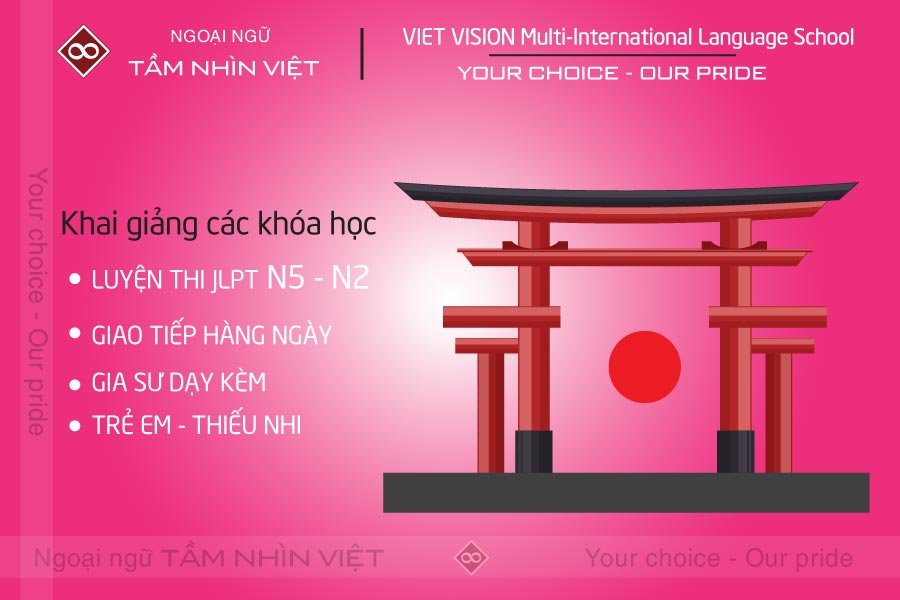Các bạn học ngữ pháp JLPT N3 tiếng Nhật sẽ cần hệ thống đầy đủ và chuyên sâu kiến thức trước kỳ thi để đạt điểm cao.
Hôm nay, chúng ta sẽ đi đến Bài 28 – Ngữ pháp JLPT N3 – 向け (muke)
Trong bài sẽ có nhiều câu ví dụ cho phần ngữ pháp để bạn có thể hiểu rõ hơn và dễ dàng tiếp thu hơn. Tuy nhiên, một điều lưu ý là bài học được thiết kế dành cho các bạn có nền tảng kiến thức tiếng Anh tốt. Nếu bạn nào không tự tin, có thể sử dụng ứng dụng Google Translate để dịch thành tiếng Việt nhé!
- Có thể bạn quan tâm: Khóa học tiếng Nhật theo yêu cầu (dạy kèm tại nhà hoặc trung tâm)

1. Giải thích ngữ pháp JLPT N3 – 向け (muke)
Meaning: Intended for; aimed at; oriented towards
Formation: Noun + 向け
2. Các câu ví dụ thông dụng nhất
海外向けの番組がますます多くなってきました。
There are more and more tv programs aimed at foreign audience.
Kaigai mukou no bangumi ga masumasu ooku natte kimashita.
ワンピースは少年向けの漫画です。
One piece is a manga aimed at young boys.
Wanpiisu wa shounen muke no manga desu.
このデザイナーは若者向けのドレスをたくさんデザインしました。
This designer made a lot of dresses for young people.
Kono dezainaa wa wakamono muke no doresu o takusan dezain shimashita.
この本は外国人向けだが、日本人が読んでもとても面白く、ためになる。
Though this book is aimed for foreigners, japanese people will also find it interesting and helpful.
Kono hon wa gaikokujin muke da ga, nihonjin ga yondemo totemo omoshiroku tame ni naru.
この映画は大人向けなので、子供は見てもつまらない。
This movie is for adults so children will find it boring.
Kono eiga wa otona muke nano de, kodomo wa mitemo tsumaranai.
この会社では、子供向けのテレビ番組を作っている。
This company is making a tv program aimed at children.
Kono kaisha dewa, kodomo muke no terebi bangumi o tsukutte iru.
これは若いお母さん向けに書かれた本です。
This book was written for young mothers.
Kore wa wakai okaasan muke ni kakareta hon desu.
マージーサイドで最高の観光客向け有料アトラクションです。
It’s the top paid-for visitor attraction on merseyside.
Maajiisaido de saikou no kankoukyaku muke yuuryou atorakushon desu.
動画のライブ・ストリーミングやインスタグラムのようなアプリを通じて、本来は業界のバイヤーや報道機関向けだったファッション・ウィークのショーを、今では一般の人たちも見られるようになりました。
Through live video streams and apps like instagram, the shows of fashion week – originally intended for industry buyers and the press – can now be seen by the general public.
Douga no raibu sutoriimingu ya insutagauramu no you na apuri o tsuujite, honrai wa gyoukai no baiyaa ya houdou kikan muke datta fasshon uiiku no shoo o, ima de wa ippan no hitotachi mo mirareru you ni narimashita.
見つけた職場は、自動車会社向けのコンピュータを作っている会社だ。
I found work at a place that make computers for automobile companies.
Mitsuketa shokuba wa, jidousha kaisha muke no konpyuuta o tsukutte iru kaisha da.
同社は企業向けにソーシャルメディア管理プラットホームを提供する。
This is a company that helps businesses manage their social media presence.
Dousha wa kigyou muke ni soosharu media kanri puratto hoomu o teikyou suru.
私たちは大企業向けのハイエンドなネット・ソリューションを供給するという事業計画をまとめました。
We put together a business plan to provide high-end internet solutions for big companies.
Watashitachi wa daikigyou muke no haiendo na netto soryuushon o kyoukyuu suru to iu jigyou keikaku o matomemashita.
彼は高品質の中所得者向けのアパートを何千戸も建設した。
He put up thousands of good quality middle-income apartments.
Kare wa kouhinshitsu no chuu shotokusha muke no apaato no nanzen ko mo kensetsu shita.
社員が日本企業向けの特注プログラムを作成している。
Our employees are writing specific software programs for japanese companies.
Shain ga nihon kigyou muke no tokuchuu puroguramu o sakusei shite iru.
明日の朝、これをメディア向けにアップロードするのか?
I’m supposed to upload this to the media tomorrow morning?
Asu no asa, kore o media muke ni appuroodo suru no ka.
そうした人々向けの職業訓練や社会的なセーフティ・ネットが必要になる。
For those people, retraining and an adequate social safety net are needed.
Sou shita hitobito muke no shokugyou kunren ya shakaiteki na seefuti netto ga hitsuyou ni naru.
Kết thúc bài học
Như vậy, chúng ta đã kết thúc Bài 28 – Ngữ pháp JLPT N3 – 向け (muke)
Hãy tiếp tục theo dõi các bài học ngữ pháp JLTP N3 tiếp theo tại đây: Tổng hợp các bài học ngữ pháp tiếng Nhật JLPT N3
BONUS: Các bạn có thể bổ sung thông tin quan trọng trong kỳ thi JLPT 2020 “TẠI ĐÂY”
Cảm ơn bạn đã quan tâm và theo dõi bài học!
